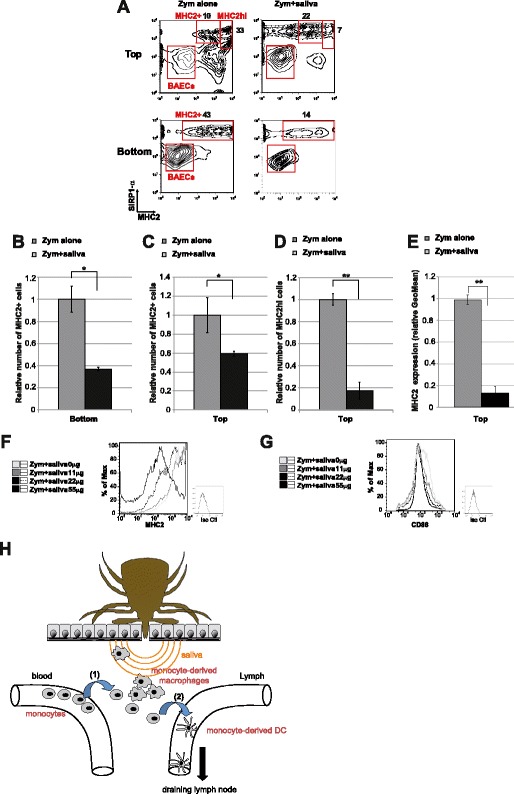Figure 3.

In vitro characterization of the dual immunosuppressive effect of tick saliva on inflammatory-induced mobilization of monocyte-derived mononuclear phagocytes. A-E Two-color flow cytometry assay of monocyte-derived cells collected from monocyte/BAEC cultures grown on collagen-coated transwells for 48 h according to the reverse-transmigration protocol. Left contour plots show conditions with zymosan alone whereas right contour plots show conditions with zymosan and tick saliva. B Comparison showing the relative number of SIRP1-α+MHCII+ cells in the bottom of the transwell in conditions with zymosan alone or with zymosan and saliva. C Comparison showing the relative number of SIRP1-α+MHCII+ cells in the top section of the transwell in conditions with zymosan alone or with zymosan and saliva. D Comparison showing the relative number of SIRP1-α+MHCIIhi cells in the top section of the transwell in conditions with zymosan alone or with zymosan and saliva. E Comparison showing the relative expression level of MHCII in SIRP1-α+MHCII+ cells in the top section of the transwell in conditions with zymosan alone or with zymosan and saliva. B-E The value for the control condition (zymosan alone) was arbitrarily set to 1. Data are presented as the mean ± SD based on four independent experiments each including at least three transwells per condition. Statistically significant differences between the two groups were determined by the Student’s t test, *P < 0.05 and **P < 0.005. (F&G) Representative histograms of MHCII and CD86 staining on SIRPα+ monocyte-derived cells incubated for 48 h with zymosan and saliva at amounts varying from 0 to 55 μg/mL. One representative experiment out of two independent experiments is shown. G Schematic representation of the effect of tick saliva on the mobilization of monocyte-derived APCs in vivo. (1) Monocytes from the blood are recruited to the area of the tick bite where a proportion of the cells differentiate into potential macrophages. (2) Potential Mo-DC precursors then migrate from this area into the draining lymphatic vessels.
